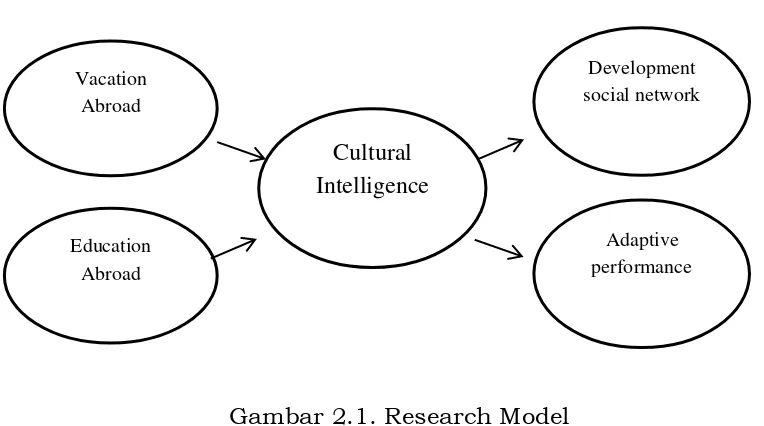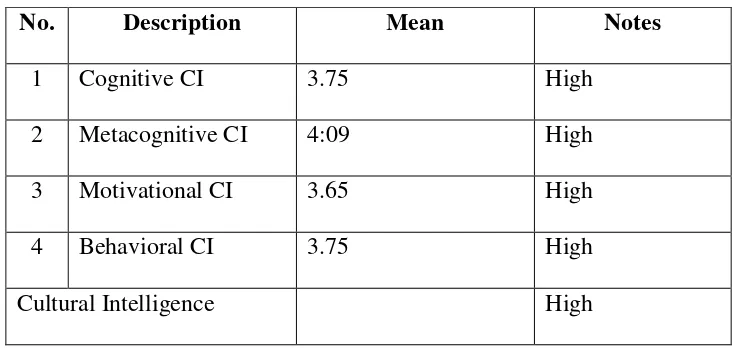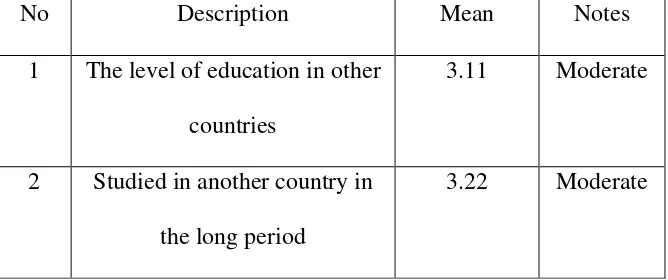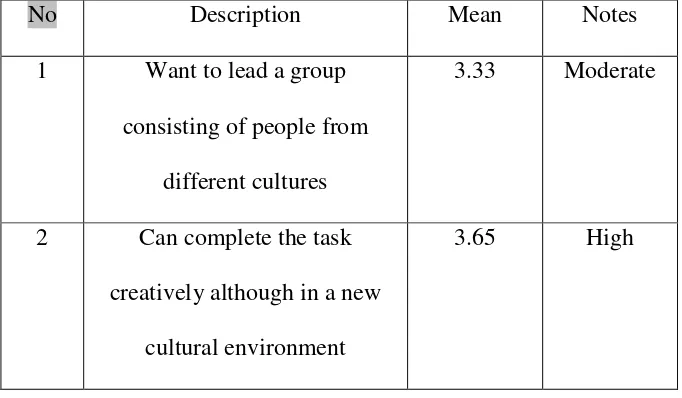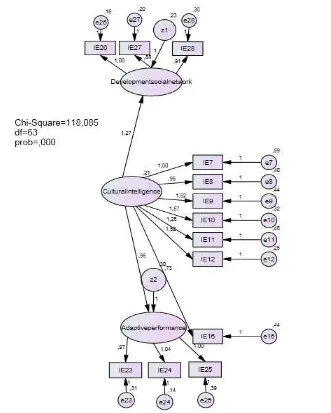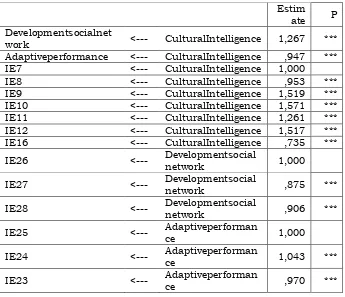Cultural Intelligence Among Indonesian Students:
Role of International Experiences and Their Impact on the Development of Social
Network and Adaptive Performance
Lieli Suharti Ariawan Abstract
Cultural Intelligence merupakan satu kemampuan yang dapat mempengaruhi seseorang saat menghadapi suatu situasi yang baru di lingkungan yang baru. Penelitian ini bertujuan mengetahui pengaruh Internasional Exposure terhadap Cultural Intelligence dan dampaknya terhadap Development Social Network dan Adaptive Performance. Responden yang terlibat dalam penelitian ini adalah mahasiswa Indonesia yang memiliki pengalaman belajar atau berkunjung ke luar negeri. Dengan menggunakan teknik purpose sampling diperoleh sejumlah 133 responden. Pengumpulan data dilakukan secara on line dengan menyebarkan kuisioner kepada responden mahasiswa Indonesia yang berada di luar negeri melalui pengurus Persatuan Pelajar Indonesia yang berada di luar negeri (Malaysia, Thailand, India). Dengan menggunakan teknik analisis structural equation modelling ditemukan bahwa Cultural Intelligence berpengaruh terhadap
Development Social Network dan Adaptive Performance. Namun penelitian tidak menemukan adanya pengaruh International Exposure
terhadap Cultural Intelligence mahasiswa.
Kata kunci : Cultural Intelligence, International Exposure, Adaptive
Performance, Development Social Network
1. Introduction
regulate the cultural differences that exist so that the workers can work harmoniously and effectively.
The problem that often occurs when a worker faces new working environment is unprepared person in experiencing cultural shock. As said by Shieh (2013) the cultural shock is the current state of someone who is already accustomed to living in a familiar environment and then move to a new environment for work, school or vacation. Cultural shock is influenced by the nature of the individual, demographic factors and the support of the organization where a person is working or studying. According to Yesil (2013), the height of Cultural Intelligence will help someone in dealing with situations of culture shock in a multi cultural which can create stress and frustration since someone who has a high Cultural Intelligence will easily adapt to communicate, behave and build friendships more to support him or her in the new environment.
It is now considered that cultural difference is important to be studied. Some researchers found Cultural Intelligence (CI) as one measuring tool in seeing someone's personality. Cultural Intelligence (CI) is the ability to adapt to the environment around which is different that the culture where the person lived before (Rose and Subramaniam, 2008). As said by Livermore (2011) a person who has a high Cultural Intelligence will be able to determine the strategy and the attitude in facing foreign culture and behavior. The level of Cultural Intelligence of someone can be measured from the Cultural Intelligence component which consists of meta-cognitive, cognitive, behavioral and motivational components (Ang, Van Dyne & Koh, 2005).
new cultures. These experiences will enrich experience and knowledge about a new culture that will improve the Cultural Intelligence.
According to Ang, Van Dyne, and Tan (2011) Cultural Intelligence has an impact on the development of a person's social network. Cultural Intelligence will affect a person's behavior in interacting with others. Someone who has a high Cultural Intelligence will be easy to interact with other cultures so that it will also make other people comfortable when they are around him or her. It makes a person to have a lot of friends who provide support in the world of work.
In addition, Cultural Intelligence also affects a person in adapting to the new environment (Soldatova and Geer, 2013). This is shown by the more creative and innovative work in person with high Cultural Intelligence compared with those with low Cultural Intelligence. Furthermore, a person is said to be able to adapt from his or her bravery in leading a new group.
The implementation of ASEAN Economic Community (AEC) will be conducted in December 2015. AEC aims to boost economic growth in the region by lowering the barrier limits in the exchange of goods, services, workers who have special skills such as nurses, doctors, teachers, and others, and also provide an opportunity to invest efforts in other ASEAN countries (Pangestu, 2009). With the entry of other ASEAN countries to Indonesia, Indonesian society is also expected to fill the void of labor in other ASEAN countries. For that we need a good adaptability to be able to work together with others, especially students as prospective employees.
increased from year to year but still below other ASEAN countries. Currently, Indonesia is ranked 108, lower that other ASEAN countries such as Malaysia (62), Singapore (9), Thailand (89), Brunei Darussalam (30) (UNDP 2013). Education can raise the HDI of a country one of which the skill education obtained from the university. It shows that the quality of students plays an important role in the development of a country both in economic and social sectors.
Problems raised in this study are the factors that influence the Cultural Intelligence, and its impact on social networks development and adaptive performance among Indonesian students. In more detail, the formulation of research problems are as follows: 1) Is vacation abroad influence the CI of Indonesian students?; 2) Is education abroad influence the CI of Indonesian students?; 3) Is social network development and adaptive performance influence the CI of Indonesian students?.
2. Literature Review and Hypothesis Formulation
2.1. Education Abroad and CI
Cultural Intelligence (CI) is a person's ability to interact with others effectively when entering the environment with different cultures (Van Dyne, Ang, and Koh, 2008). CI may explain why a person can survive in the new environment and culture while others are difficult to adapt. Based on Early and Ang (2003) and Ang, Van Dyne, and Tan (2011), CI has four components, namely Metacognitive, Cognitive, Behavioral, and Motivational.
able to adapt with the new environment. In contrast to cognitive CI, meta-cognitive CI tends to show how to find a gap to the minds of others and be able to commune with the current situation (Van Dyne, Ang and Livermore, 2010).
Furthermore, according to Van Dyne et al (2012) motivational CI is the mental attitude to encourage someone to pay attention and learn about the cultural differences that the person will be or are being experienced. High and low CI are influenced by Intrinsic Interest, Extrinsic Interest and Self-Confidence (Van Dyne et al, 2012; Ng, Van Dyne, Ang, 2012).
Kitsantas and Meyers (2001) defined education aboard as all programs that aimed to educate that was performed outside the geographical lines of original country. Taking education abroad aims to raise awareness of the interdependence among countries, increase the value of difference, and gain other important information about other countries. It is expected that after taking education abroad, students can compete in the global market, gain an increase in foreign language and have a broad network.
Education abroad will affect the CI because according Crowne (2008) study abroad will give an opportunity to a person to interact with others from different cultures. By getting along with people in different culture, someone must adjust to new cultural habits in order to avoid discrimination or other negative treatment as a result of an error in interacting with new environments (Ang, Van Dyne and Tan, 2011). Therefore, someone who get education abroad has a potential to improve his or her CI. Thus the following hypothesis can be formulated:
H1: Education abroad will have a positive impact on CI
Takeuchi et al., (2005) defined vacation abroad as an activity that had no connection with the work performed abroad. Vacation abroad is aimed to give a rest to the mind, so that the mind can be cleared when it is used in working again. For the company, usually vacation abroad is also used as a bonus to employees who have achievements to motivate others in working to get the same bonus to those employees.
In a study conducted by Tarique and Takeuchi (2008) in Ang, Van Dyne, and Tan (2011) it was found that vacation or holiday affected the height of CI. The number of countries that had been visited became the deciding factor for high and low CI because by visiting many different countries someone would had more interaction with strangers. A lot of interaction with a diverse culture will enhance knowledge and provide a diverse experience. Based on the above rationale, the following hypothesis can be formulated:
H2: Vacation Abroad will have a positive impact on CI
2.3. CI and Adaptive Performance
According to Ng and Early (2006), CI has an influence on adaptive performance that is the individual's ability to adapt to his or her environment. Someone who has a high CI will be easy to adjust his behavior to the new environment. Van der Zee et al., 2004 in Leung, Ang, and Tan, 2014), found that students who had high CI could more easily adapt to the working environment with cultural diversity. From the results of research conducted by Harrison and Brower (2011) it was also revealed that students who were able to adapt to the environment had a high level of CI. Based on the logic of thinking above, the following hypotheses can be formulated:
H3: CI will have a positive impact on Adaptive Performance
2.4. CI and Social Network
According to De Lange, Agneessens, and Waege (2004), a structured relationship and have reciprocal relationships between individuals is referred to as social network. An individual has a social relationship network both formally and informally. The level of a person's ability to develop a social network is known as the capability of social networks development, which can be measured by the number of friends and local diversity of the friends.
H4: CI will have a positive impact on Social Network Development
2.5 Research Model
Gambar 2.1. Research Model
3. Research Methods
This study was an explanatory research that explained the correlation between variables that would be examined each other and would be examined by using a quantitative approach.
The populations in this study were students from Indonesia who had experiences abroad, both the educational experience abroad and also experience of traveling abroad. Because the number of the population studied is not certainly known, the sampling in this study used purposive sampling technique.
The number of samples examined here were in accordance with that recommended by Hair (2000), with the total number of 140 respondents, but those could be processed were only 133 respondents where the number of study samples for
Vacation Abroad
Cultural Intelligence
Development social network
Education Abroad
hypotheses test used Structural Equation Model (SEM) ranged between 100-200 samples.
The questionnaires distribution was conducted to the respondents of Indonesian students who were abroad, were collected online by contacting any Indonesian Students Association committee abroad (Malaysia, Thailand, India).
The measurement of Cultural Intelligence variable consisted of cognitive CI, metacognitive CI, motivational CI, behavioral CI by adopting the Ang, Van Dyne and Tan scale (2011). Vacation abroad variable was measured by question items by using a Ng, Van Dyne, Ang scale (2012). Education abroad used a Crowne scale (2008); Adaptive Performance and Development of Social Network variables adopted the scale developed by Ng, Van Dyne, Ang, (2012).
Every answer that was spread from online questionnaires was administered by using google drive. The entered data were processed directly into the form of .xls data in Microsoft Excel program. Answers and responses from the respondents were measured by using a Likert scale with responses from 1 (strongly disagree) to 5 (strongly agree).
The analysis technique used in this study was Structural Equation Model (SEM). The first analysis process conducted were validity and reliability tests of the latent constructs by using confirmatory factor analysis (CFA) to determine whether the indicator variables could actually represented the latent variables or not.
4. Findings and Discussion
To determine the tendency of respondents’ answers in the questionnaires then the writer will present the descriptive statistics to see the average value (the mean). The scores were grouped into intervals of the study variables.
Table 4.1. Descriptive Statistics of CI Variable
No. Description Mean Notes
1 Cognitive CI 3.75 High
2 Metacognitive CI 4:09 High
3 Motivational CI 3.65 High
4 Behavioral CI 3.75 High
Cultural Intelligence High
Source: The primary analysis data in 2015
From the Table 4.1 above it could be seen that the highest value was metacognitive CI. Metacognitive CI owned by the respondent wsa especially when the respondents interacted in another culture to prepare the right words in communication. The average value of the overall Motivational CI was also likely to be high with a value of 3.65. From the analysis of the study data it could be concluded that the respondents had a high Motivational CI especially when the respondents could reduce or controlled the stress experienced when interacting with a new culture.
Table 4.2. Descriptive Statistics of Vacation Abroad Variable
Source: The primary analysis data in 2015
The above data showed that students did not have a long experience in holidays abroad. International Exposure (IE) of 18 showed that the students were just been on a vacation to a few countries with a value of 2.94. The intensity of a vacation in the near future to other countries of very few respondents was indicated the value of 1.83 which was categorized as low.
Table 4.3. Descriptive Statistics of Education Abroad Variable
No. Description Mean Notes
1 Vacation to some other countries in a long period
2.64 Moderate
2 Vacation to some other countries
2.94 Moderate
3 Intensity of vacation to another country in the near future
1.83 Low
No Description Mean Notes
1 The level of education in other countries
3.11 Moderate
2 Studied in another country in the long period
Source: The primary analysis data in 2015
By looking at the acquisition value of each Education abroad variable above, it could be explained that education in the long term, got the highest value with a value of 3:22. From these values it could be said that the respondents had little international experience in the terms of going abroad to study The data showed that a few number Indonesian students studied in several countries.
Table 4.4. Descriptive Statistics of Adaptive Performance Variable 3 Studied in several countries 1.32 Very Low
No Description Mean Notes
1 Want to lead a group consisting of people from
different cultures
3.33 Moderate
2 Can complete the task creatively although in a new
cultural environment
International Exposure (IE) of 24 in table 4.4 above got the highest average value of 3.67 which showed that the respondents could complete the task creatively although in a new cultural environment with a value of 3.65. It can be said that the respondents could adapt to a new culture when it was viewed from a performance held mainly in the terms of the completion of the task obtained. Overall average value of Adaptive Peformance variable was also likely to be high with a value of 3:52.
Table 4.5. Descriptive Statistics of Social Network Development Variable 3 Want to interact with the
unknown/uncertain environment
3.57 High
Average 3.52 Tinggi
No Description Mean Notes
1 Have a lot of friends from other cultures
3.95 High
2 Have a lot of friends with a diverse culture
3.98 High
3 Still in touch with friends who are known from different
Table 4.5 explained that the respondents had many friends with a diverse culture as shown by the value of 3.98 which was the highest value and the entire average value of Social Network Development tent to be high with a value of 3.95.
4.2 Study Results
At this stage, the determination of the initial model and further research is performed and then also the model identification. From the convergent and discriminant validity tests, some indicators did not have a significant correlation with the latent, so the modification was necessary, that was by eliminating the Vacation Abroad variable because the indicator did not exist which may explain this latent.
Figure 4.1 Initial Model
Besides, both latent variables did not meet the assumption of reliability. So we can say that there were no indicators that could explain the exogenous latent variables of Vacation Abroad and Education Abroad. Thus, in the second modeling these two variables would be eliminated.
In the stage of Endogenous CFA II, the modification was performed by eliminating some of the indicators that had weak correlation with the latent, in this case IE2, IE3, IE4, IE5, IE14, and IE15. In the stage of Endogenous CFA III, although it had not yet meet the assumption of reliability but from the table above the criteria had
countries or cultures
shown good results. So model modification of endogenous CFA was no longer needed. The next stage was making whole structural model based on the CFA that had been made.
Here are the specifications of the final model after the modification.
The degrees of freedom value was 63 > 0, which indicated that the model was included in the overidentified criteria
4.3 Hypothesis Test
Table 4.2. Regression Weights: (Group number 1 - Default model)
Estim
ate P
Developmentsocialnet
work <--- CulturalIntelligence 1,267 ***
Adaptiveperformance <--- CulturalIntelligence ,947 ***
IE7 <--- CulturalIntelligence 1,000
IE8 <--- CulturalIntelligence ,953 ***
IE9 <--- CulturalIntelligence 1,519 ***
IE10 <--- CulturalIntelligence 1,571 ***
IE11 <--- CulturalIntelligence 1,261 ***
IE12 <--- CulturalIntelligence 1,517 ***
IE16 <--- CulturalIntelligence ,735 ***
IE26 <--- Developmentsocial
network 1,000
IE27 <--- Developmentsocial
network ,875 ***
IE28 <--- Developmentsocial
network ,906 ***
IE25 <--- Adaptiveperforman
ce 1,000
IE24 <--- Adaptiveperforman
ce 1,043 ***
IE23 <--- Adaptiveperforman
ce ,970 ***
The influence or correlation test for the hypothesis 1 and 2 could not be conducted since there were no indicators that could explain the latent variables of Vacation Abroad and Education Abroad. If it is necessary to analyze the correlation, so in this case, Hypothesis 1 and 2 were rejected.
Development with the structural form of the model was social network Development = 1.27 Cultural Intelligence + 0.23 and Adaptive Performance = 0.95 Cultural Intelligence + 0.31
Based on the model it appears that the correlation between CI and Adaptive Performance and the correlation between CI and Social Network Development had a positive correlation. The measurement models was:
(insert statistical data)
4.4 Discussion
From the research that has been conducted, hypothesis 1 and hypothesis 2 that education abroad and vacation abroad had an impact on CI was not proven. This was presumably due to lack of precise instruments used in this study. Earlier research instrument of vacation abroad and education abroad was initially used for managers as respondents. So when the same instrument was used for student respondents, the context was not necessarily the same.
height of Indonesian students in this study was suspected to be affected due to interaction with other cultures when they performed part time work.
According to Ng, KY, Van Dyne, L., & Ang, S. (2012) education abroad should have a positive impact on Cultural Intelligence, but in fact it was not proven in this study. The possibility of constraints experienced here is the same with vacation abroad that is the limited funds that do not allow students to study abroad in various countries, and in a long period of time.
Students’ Residence and environment also influence the effect of education with Cultural Intelligence. As stated by the Indonesian Students Association board in Thailand (PERMITHA) that students are generally clustered in the residence. From the information obtained from the PPI management of Thailand, on average the students there were placed or seeking shelter in the Indonesian people who were already there before. So it can be presumed that the living environment is not conducive to interact with many cultures.
necessity that must be met by every individual, especially holidays abroad which require a lot of funds.
At this study, Cultural Intelligence was proved to influence Social Network Development and Adaptive Performance. This is in line with the study conducted by Ng, KY, Van Dyne, L., & Ang, S. (2012). By having a high Cultural Intelligence, it is possible to easily search for friends to socialize. Knowledge of foreign languages and awareness of cultural differences affect a person's ability to easily fit into a new environment and get new friends from different tribal customs and culture. If someone does not have a high Cultural Intelligence then it is difficult to get new friends in the new environment, even there will be many disputes and disharmony due to frequent misunderstanding about the customs one another.
A person who holds a high Cultural Intelligence will also benefit in terms of adapting to the new environment which can be seen from the performance of the work done. By having a high Cultural Intelligence then one does not hesitate to be placed in a new environment that is not much information about the place, especially the culture and customs that are owned by local people. A student would need to see this, because a prospective employee would normally be placed in the cities and other countries in the future work time. Has a high Intelligence Cultural certainly have a positive impact at work so someone is not awkward to interact with the local community which has different culture and the way of life.
overcome it so he or she will work with more creative and productive without the need to think about cultural shock derived from the surrounding environment.
5. CLOSING
5.1 Conclusion
This study showed that the Cultural Intelligence had an impact on Development Social Network and Adaptive performance.
Vacation abroad and education abroad were not proved to affect CI in this study. However it was found that Indonesian students could increase their CI through mingle with people in other countries, among others through a part-time job in a foreign country.
5.2 Theoretical Implications
In this study it was found that there was no impact of International Exposure (Vacation Abroad and Education Abroad) on Cultural Intelligence of Indonesian students. The measurements were equated with the study conducted by Ng and Early (2006) which actually could not be applied to the student respondents. Previous research took a sample of workers from other countries who had better financial condition than Indonesian students as the samples in this study.
ability which can affect the number of social relationships outside the geographic boundaries with different cultures and ethnicities.
5.3 Suggetions
1. Indonesian students are expected to further enhance the Cultural Intelligence to face the ASEAN Economic Community. This can be improved by better studying the knowledge of other cultures and willing to try to interact with others with different cultures. By doing so will enhance the students’ readiness in facing the ASEAN Economic Community which will be immediately applied. 2. The universities in Indonesia should begin to give students the opportunity to
conduct student exchange and training abroad to boost Cultural Intelligence 3. For the Government to prepare programs that support students in facing the
ASEAN Economic Community such as foreign language training and identification of other cultures. The program can be performed periodically an intensively sho that the implementation of the program is not merely a formality.
5.4 Study Limitations and Suggestions for the Further Study
Threre was an instrument in this study that caused the data could not be processed properly. By replacing it by other instrument according to the study to be conducted is expected to produce better data. Therefore, further research can replace the study instrument with more suitable instrument so as to produce different and better study.
method can also be conducted that may increase the accuracy and different understanding of the study.
In this study, there was also a constraint in collecting data from respondents that caused the data to be taken did not have the general characteristics of respondents and we could not see the differences between one respondents group with another group. It could be that viewing respondents with different economic condition may provide different answers compared to this study.
The further studies can search respondents by paying attention to the difference of respondent’s characteristics or by comparing answers from one respondent’s
characteristic with another characteristic. The characteristics to be taken are for example economic and geographic aspects difference and behaviour difference of each individual as a respondent. Thus, the further studies are expected to provide better results by taking more complex data.
DAFTAR PUSTAKA
Andadari, R., K., & Fernandes J., A., P.,S., E (2012). Presepsi Mahasiswa Dalam Pemberlakuan Masyarakat Ekonomi ASEAN.
Ang, S., Van Dyne, L., & Koh, C.S.K. (2005). Personality Correlates of The Four Factor Model of Cultural Intelligence.Group and Organization Management, 31, 100-123.
Ang, S., Van Dyne, L., & Tan, M.L. (2011). Cultural intelligence dalam R. J. Sternberg & S. B. Kaufman (Eds.), Cambridge Handbook on Intelligence (pp. 582-602). New York: Cambridge Press.
Crowne, K., A. (2008) What Leads to Cultural Intelligence? Business Horizon, 51 391-399.
De Lange, D., Agneessens, F., & Waege, H. (2004) Asking Social Network Questions: A Quality Assessment of Different Measures.
Earley, P.C. & Ang, S. (2003). Cultural Intelligence: An Analysis of Individual Interactions Across Cultures. Palo Alto, CA: Stanford University Press.
Ferdinand, A. (2002). Structural Equation Modeling dalam Penelitian Manajemen, Second Edition. Semarang: BP Universitas Diponegoro.
Friedman, T., L. (2005). The World Is Flat: A Brief History of the Twenty-First Century. New York: Farrar, Straus and Giroux.
Harrison, J., K., Brower H., H. (2011). The Impact of Cultural Intelligence and Psychological Hardiness on Homesickness among Study Abroad Students. The Interdisciplinary Journal of Study Abroad. Fall 2011, Vol. 21, p41.
Kanten, Pelin (2014). The Effect of Cultural Intelligence on Career Competencies and Customer-Oriented Service Behaviors. Journal of the School of Business Cilt/Vol:43, Sayı/No:1, 2014, 100-119 ISSN: 1303-1732.
Kitsantas, A., Meyers, J. (2001) Studying Abroad: Does It Enhance College Student Cross-Cultural Awareness? Paper presented at the combined Annual Meeting of the San Diego State University and the U.S. Department of Education Centers for International Business Education and Research.
Leung, K., Ang, S., & Tan, M., L. (2014) Intercultral Competence. Annu. Rev. Organ. Psychol. Organ. Behav. 2014.1:489-519.
Livermore, D. (2011). The Cultural Intelligence Difference. New York : AMACOM.
Ng, K.Y., & Earley, P.C. (2006). Culture and Intelligence: Old constructs, new frontiers. Group and Organization Management, 31, 4-19.
Ng, K.Y., Van Dyne, L., & Ang, S. (2012). Cultural Intelligence: A review, reflections, and recommendations for future research dalam A.M. Ryan, F.T. Leong, & F.L. Oswald (Eds.), Conducting multinational research: Applying organizational psychology in the workplace (pp. 29-58). Washington, DC: American Psychological Association.
Rockstuhl, T., Seiler, S., Ang, S., Van Dyne, L, & Annen, H. (2011). Beyond General Intelligence (IQ) and Emotional Intelligence (EQ): The role of cultural intelligence (CQ) on cross-border leadership effectiveness in a globalized world. Journal of Social Issues. 67: 825-840.
Rose R.C, Subramaniam N.K. (2008). A Review on Individual Differences and Cultural Intelligence. The Journal of International Social Research. 1, 4, 504-522
Sekaran, U. (2011). Research Methods for Business. Metodologi Penelitian untuk Bisnis, Edisi 4 (Terjemahan). Jakarta: Salemba Empat.
Shieh, C.J. (2013). Effects of Culture Shock and Cross-Cultural Adaptation on Learning Satisfaction of Mainland China Students Studying in Taiwan. Revista Internacional de Sociología (RIS). DOI:10.3989/ris.2013.08.10
Soldatova, G., Geer, M. (2013) “Glocal” Identity, Cultural Intelligence, and Language Fluency. Procedia - Social and Behavioral Sciences 86 ( 2013 ) 469 – 474.
Takeuchi, R., Tesluk, P.E., Yun, S., & Lepak, D.P. (2005). An integrative view of international experience. Academy of Management Journal, 48, 85-100. Doi:10.5465/AMJ.2005.15993143
United Nation Development Program (2013) Human Development Report
Van Dyne, L., Ang, S., & Koh, C. (2008). Development and Validation of The CQS: The cultural intelligence scale dalam S. Ang, & L. Van Dyne, (Eds.) Handbook on Cultural Intelligence: Theory, Measurement and Applications (pp. 16-38). Armonk, NY: M.E. Sharpe.
Van Dyne, L., Ang, S., & Livermore, D. (2010). Cultural Intelligence: A pathway for leading in a rapidly globalizing world dalam K.M. Hannum. B. McFeeters, & L. Booysen (Eds.), Leadership Across Differences (pp. 131-138). San Francisco, CQ: Pfeiffer.
Van Dyne, L., Ang, S., Ng, K., Y., Rockstuhl, T., Tan, M.L., & Koh, C. (2012). Sub-Dimensions of The Four Factor Model of Cultural Intelligence: Expanding the conceptualization and measurement of cultural intelligence (CQ). Social and Personal Psychology.
Yesil, S. (2013). The Impact of Cultural Intelligence (CQ) on Cross-Cultural Job Satisfaction (CCJS) and International Related
Performance (IRP). Journal of Culture, Society and Development. An Open Access International Journal Vol.1
